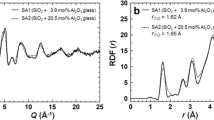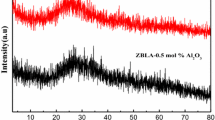Abstract
The sound velocities (compressional wave velocity [VP] and shear wave velocity [VS]) of four types of aluminosilicate glasses (Mg3Al2Si6O18 (MAS), Ca3Al2Si6O18 (CAS), Na3AlSi3O9 (NAS), and K3AlSi3O9 (KAS)) are measured using the ultrasonic technique at high pressures of up to 7.8 GPa. The VP and VS of MAS glass decrease up to a pressure of 2 GPa and subsequently increase with increasing pressure. The pressure dependence of the CAS glass velocities changes; VP remains almost constant when P ≤ 2 GPa and subsequently increases above 2 GPa. The minimum VS can be observed at approximately 2 GPa, which is similar to that in the case of the MAS glass. The sound velocities of the NAS and KAS glasses monotonically increase with pressure. The increments in the VP and VS of the KAS glass show less sensitivity when compared with that observed in the case of the NAS glass within the pressure range of our experiments. The differences in the properties of the modifying cations in the glasses, such as size ([5]Mg2+ < [~6−7]Ca2+ ≈ [~6−7]Na+ < [~9−11]K+) and field strength (ratio of the charge to the square radius), can be considered responsible for each sound velocity trend. The effects of the cation field strength on the structure and elasticity of the aluminosilicate glasses could govern the pressure-induced change in sound velocities. The results indicate that the type and amount of cation control the elastic behavior of silicate glass under high pressure.






Similar content being viewed by others
References
Allwardt JR, Poe BT, Stebbins JF (2005a) The effect of fictive temperature on Al coordination in high-pressure (10 GPa) sodium aluminosilicate glasses. Am Mineral 90:1453–1457. https://doi.org/10.2138/am.2005.1736
Allwardt JR, Stebbins JF, Schmidt BC, Frost DJ, Withers AC, Hirschmann MM (2005b) Aluminum coordination and the densification of high-pressure aluminosilicate glasses. Am Mineral 90:1218–1222. https://doi.org/10.2138/am.2005.1836
Allwardt JR, Stebbins JF, Terasaki H, Du L-S, Frost DJ, Withers AC, Hirschmann MM, Suzuki A, Ohtani E (2007) Effect of structural transitions on properties of high-pressure silicate melts: 27Al NMR, glass densities, and melt viscosities. Am Mineral 92:1093–1104. https://doi.org/10.2138/am.2007.2530
Angell CA (1985) Spectroscopy simulation and scattering, and the medium range order problem in glass. J Non-Cryst Solids 73:1–17. https://doi.org/10.1016/0022-3093(85)90334-5
Bean VE, Akimoto S, Bell PM, Block S, Holzapfel WB, Manghnani MH, Nicol MF, Stishov SM (1986) Another step toward an international practical pressure scale: 2nd AIRAPT IPPS task group report. Physica B+C 139–140:52–54. https://doi.org/10.1016/0378-4363(86)90521-8
Clark AN, Lesher CE, Jacobsen SD, Wang Y (2016) Anomalous density and elastic properties of basalt at high pressure: reevaluating of the effect of melt fraction on seismic velocity in the Earth’s crust and upper mantle. J Geophys Res Solid Earth 121:4232–4248. https://doi.org/10.1002/2016JB012973
Cook RK (1957) Variation of elastic constants and static strains with hydrostatic pressure: a method for calculation from ultrasonic measurements. J Acoust Soc Am 29:445–449. https://doi.org/10.1121/1.1908922
Cormier L, Neuville DR (2004) Ca and Na environments in Na2O–CaO–Al2O3–SiO2 glasses: influence of cation mixing and cation–network interactions. Chem Geol 213:103–113. https://doi.org/10.1016/j.chemgeo.2004.08.049
Domine F, Piriou B (1986) Raman spectroscopic study of the SiO2–Al2O3–K2O vitreous system; distribution of silicon second neighbors. Am Mineral 71:38–50. https://pubs.geoscienceworld.org/ammin/article-abstract/71/1-2/38/41805/Raman-spectroscopic-study-of-the-SiO2-Al2O3-K2O
Dove MT (1997) Theory of displacive phase transitions in minerals. Am Mineral 82:213–244. https://doi.org/10.2138/am-1997-3-401
Drewitt JWE, Jahn S, Sanloup C, de Grouchy C, Garbarino G, Hennet L (2015) Development of chemical and topological structure in aluminosilicate liquids and glasses at high pressure. J Phys: Condens Matter 27:105103. https://doi.org/10.1088/0953-8984/27/10/105103
Elliott SR (1992) The origin of the first sharp diffraction peak in the structure factor of covalent glasses and liquids. J Phys: Condens Matter 4:7661–7678. https://doi.org/10.1088/0953-8984/4/38/003
Funamori N, Yamamoto S, Yagi T, Kikegawa T (2004) Exploratory studies of silicate melt structure at high pressures and temperatures by in situ X-ray diffraction. J Geophys Res 109:B03203. https://doi.org/10.1029/2003JB002650
George AM, Stebbins JF (1996) Dynamics of Na in sodium aluminosilicate glasses and liquids. Phys Chem Miner 23:526–534. https://doi.org/10.1007/BF00242002
Ghosh DB, Karki BB (2018) First-principles molecular dynamics simulations of anorthite (CaAl2Si2O8) glass at high pressure. Phys Chem Minerals 45:575–587. https://doi.org/10.1007/s00269-018-0943-4
Ghosh DB, Karki BB, Stixrude L (2014) First-principles molecular dynamics simulations of MgSiO3 glass: structure, density, and elasticity at high pressure. Am Mineral 99:1304–1314. https://doi.org/10.2138/am.2014.4631
Guignard M, Cormier L (2008) Environments of Mg and Al in MgO–Al2O3–SiO2 glasses: a study coupling neutron and X-ray diffraction and Reverse Monte Carlo modeling. Chem Geol 256:111–118. https://doi.org/10.1016/j.chemgeo.2008.06.008
Hennet L, Pozdnyakova I, Cristiglio V, Cuello GJ, Jahn S, Krishnan S, Saboungi M-L, Price DL (2007) Short- and intermediate-range order in levitated liquid aluminates. J Phys: Condens Matter 19:455210. https://doi.org/10.1088/0953-8984/19/45/455210
Higo Y, Inoue T, Li B, Irifune T, Liebermann RC (2006) The effect of iron on the elastic properties of ringwoodite at high pressure. Phys Earth Planet Inter 159:276–285. https://doi.org/10.1016/j.pepi.2006.08.004
Jackson WE, Brown GE, Ponader CW (1987) X-ray absorption study of the potassium coordination environment in glasses from the NaAlSi3O8-KAlSi3O8 binary: structural implications for the mixed-alkali effect. J Non-Cryst Solids 93:311–322. https://doi.org/10.1016/S0022-3093(87)80177-1
Kohara S, Akola J, Morita H, Suzuya K, Weber JKR, Wilding MC, Benmore CJ (2011) Relationship between topological order and glass forming ability in densely packed enstatite and forsterite composition glasses. Proc Natl Acad Sci 108:14780–14785. https://doi.org/10.1073/pnas.1104692108
Kondo K, Iio S, Sawaoka A (1981) Nonlinear pressure dependence of the elastic moduli of fused quartz up to 3 GPa. J Appl Phys 52:2826–2831. https://doi.org/10.1063/1.329012
Kuryaeva RG (2012) Effect of alkali cations on the compressibility of MAlSi3O8 glasses (M=Na, K, Rb, Cs) in the pressure range up to 6.0 GPa. Phys Chem Glas 53:8. https://www.researchgate.net/publication/263385312
Lin C-C, Liu L (2006) Composition dependence of elasticity in aluminosilicate glasses. Phys Chem Miner 33:332–346. https://doi.org/10.1007/s00269-006-0084-z
Liu J, Lin J-F (2014) Abnormal acoustic wave velocities in basaltic and (Fe, Al)-bearing silicate glasses at high pressures. Geophys Res Lett 41:8832–8839. https://doi.org/10.1002/2014GL062053
McMillan P (1984) A Raman spectroscopic study of glasses in the system CaO–MgO–SiO2. Am Mineral 69:645–659. http://www.minsocam.org/ammin/AM69/AM69_645.pdf
Moulton BJA, Henderson GS, Martinet C, Martinez V, Sonneville C, de Ligny D (2019) Structure—longitudinal sound velocity relationships in glassy anorthite (CaAlSi2O8) up to 20 GPa: an in situ Raman and Brillouin spectroscopy study. Geochim Cosmochim Acta 261:132–144. https://doi.org/10.1016/j.gca.2019.06.047
Mysen BO (1987) Magmatic silicate melts: relations between bulk composition, structure and properties. In: Mysen BO (ed) Magmatic processes: physicochemical principles. The Geochemical Society, Penn, pp 375–399
Mysen BO (1988) Structure and properties of silicate melts. Elsevier, Amsterdam
Mysen BO, Virgo D, Kushiro I (1981) The structure role of aluminum in silicate melts—a Raman spectroscopic study at 1 atmosphere. Am Mineral 66:678–701. http://www.minsocam.org/ammin/AM66/AM66_678.pdf
Mysen BO, Virgo D, Seifert FA (1982) The structure of silicate melts: implications for chemical and physical properties of natural magma. Rev Geophys 20:353–383. https://doi.org/10.1029/RG020i003p00353
Navrotsky A, Peraudeau G, McMillan P, Coutures J-P (1982) A thermochemical study of glasses and crystals along the joins silica-calcium aluminate and silica-sodium aluminate. Geochim Cosmochim Acta 46:2039–2047. https://doi.org/10.1016/0016-7037(82)90183-1
Neuville DR, Cormier L, Flank A-M, Briois V, CASsiot D (2004) Al speciation and Ca environment in calcium aluminosilicate glasses and crystals by Al and Ca K-edge X-ray absorption spectroscopy. Chem Geol 213:153–163. https://doi.org/10.1016/j.chemgeo.2004.08.039
Okuno M, Marumo F (1993) The structure analyses of pyrope (Mg3Al2Si3O12) and grossular (Ca3Al2Si3O12) glasses by X-ray diffraction method. Mineral J 16:407–415. https://doi.org/10.2465/minerj.16.407
Polian A, Grimsditch M (1993) Sound velocities and refractive index of densified a-SiO2 to 25 GPa. Phys Rev B 47:13979–13982. https://doi.org/10.1103/PhysRevB.47.13979
Price DL, Moss SC, Reijers R, Saboungi M-L, Susman S (1988) Intermediate-range order in glasses and liquids. J Phys C Solid State Phys 21:L1069–L1072. https://doi.org/10.1088/0953-8984/1/5/017
Renou R, Soulard L, Lescoute E, Dereure C, Loison D, Guin J-P (2017) Silica glass structural properties under elastic shock compression: experiments and molecular simulations. J Phys Chem C 121:13324–13334. https://doi.org/10.1021/acs.jpcc.7b01324
Russell JK, Giordano D (2005) A model for silicate melt viscosity in the system CaMgSi2O6–CaAl2Si2O8–NaAlSi3O8. Geochim Cosmochim Acta 69:5333–5349. https://doi.org/10.1016/j.gca.2005.06.019
Sakamaki T, Kono Y, Wang Y, Park C, Yu T, Jing Z, Shen G (2014) Contrasting sound velocity and intermediate-range structural order between polymerized and depolymerized silicate glasses under pressure. Earth Planet Sci Lett 391:288–295. https://doi.org/10.1016/j.epsl.2014.02.008
Sanchez-Valle C, Bass JD (2010) Elasticity and pressure-induced structural changes in vitreous MgSiO3-enstatite to lower mantle pressures. Earth Planet Sci Lett. https://doi.org/10.1016/j.epsl.2010.04.034
Sato T, Funamori N (2010) High-pressure structural transformation of SiO2 glass up to 100 GPa. Phys Rev B. https://doi.org/10.1103/PhysRevB.82.184102
Schroeder J, Bilodeau TG, Zhao X-S (1990) Brillouin and Raman scattering from glasses under high pressure. High Press Res 4:531–533. https://doi.org/10.1080/08957959008246178
Shannon RD (1976) Revised effective ionic radii and systematic studies of interatomic distances in halides and chalcogenides. Acta Crystallogr A 32:751–767. https://doi.org/10.1107/S0567739476001551
Shimoda K, Miyamoto H, Kikuchi M, Kusaba K, Okuno M (2005) Structural evolutions of CaSiO3 and CaMgSi2O6 metasilicate glasses by static compression. Chem Geol 222:83–93. https://doi.org/10.1016/j.chemgeo.2005.07.003
Shimoda K, Tobu Y, Hatakeyama M, Nemoto T, Saito K (2007) Structural investigation of Mg local environments in silicate glasses by ultra-high field 25Mg 3QMAS NMR spectroscopy. Am Mineral 92:695–698. https://doi.org/10.2138/am.2007.2535
Stebbins JF, Xu Z (1997) NMR evidence for excess non-bridging oxygen in an aluminosilicate glass. Nature 390:60–62. https://doi.org/10.1038/36312
Stebbins JF, Wu J, Thompson LM (2013) Interactions between network cation coordination and non-bridging oxygen abundance in oxide glasses and melts: insights from NMR spectroscopy. Chem Geol 346:34–46. https://doi.org/10.1016/j.chemgeo.2012.09.021
Suito K, Miyoshi M, Sasakura T, Fujisawa H (1992) Elastic properties of obsidian vitreous SiO2 and vitreous GeO2 under high pressure up to 6 GPa. In: Syono Y, Manghnani MH (eds) High pressure research: applications to earth and planetary sciences. Terra Scientific Publishing Company, Tokyo, pp 209–211
Sun N, Stixrude L, de Koker N, Karki BB (2011) First principles molecular dynamics simulations of diopside (CaMgSi2O6) liquid to high pressure. Geochim Cosmochim Acta 75:3792–3802. https://doi.org/10.1016/j.gca.2011.04.004
Susman S, Volin KJ, Montague DG, Price DL (1990) The structure of vitreous and liquid GeSe2: a neutron diffraction study. J Non-Cryst Solids 125:168180. https://doi.org/10.1016/0022-3093(90)90336-K
Taylor M, Brown GE (1979) Structure of mineral glasses—II. The SiO2–NaAlSiO4 join. Geochim Cosmochim Acta 43:1467–1473. https://doi.org/10.1016/0016-7037(79)90141-8
Uchino T, Sakka T, Ogata Y, Iwasaki M (1993) Local structure of sodium aluminosilicate glass: an ab initio molecular orbital study. J Phys Chem 97:9642–9649. https://doi.org/10.1021/j100140a019
Walker AM, Sullivan LA, Trachenko K, Bruin RP, White TOH, Dove MT, Tyer RP, Todorov IT, Wells SA (2007) The origin of the compressibility anomaly in amorphous silica: a molecular dynamics study. J Phys: Condens Matter 19:275210. https://doi.org/10.1088/0953-8984/19/27/275210
Weigel C, Le Losq C, Vialla R, Dupas C, Clément S, Neuville DR, Rufflé B (2016) Elastic moduli of XAlSiO4 aluminosilicate glasses: effects of charge-balancing cations. J Non-Cryst Solids 447:267–272. https://doi.org/10.1016/j.jnoncrysol.2016.06.023
Whittington A, Richet P, Holtz F (2000) Water and the viscosity of depolymerized aluminosilicate melts. Geochim Cosmochim Acta 64:3725–3736. https://doi.org/10.1016/S0016-7037(00)00448-8
Xiang Y, Du J, Smedskjaer MM, Mauro JC (2013) Structure and properties of sodium aluminosilicate glasses from molecular dynamics simulations. J Chem Phys 139:044507. https://doi.org/10.1063/1.4816378
Yokoyama A, Matsui M, Higo Y, Kono Y, Irifune T, Funakoshi K (2010) Elastic wave velocities of silica glass at high temperatures and high pressures. J Appl Phys 107:123530. https://doi.org/10.1063/1.3452382
Yue Y, Christiansen J (1999) Fragility and flow behaviour of several phosphate and silicate melts. Phosphorus Res Bull 10:497–502. https://doi.org/10.3363/prb1992.10.0_497
Zha C, Hemley RJ, Mao H, Duffy TS, Meade C (1994) Acoustic velocities and refractive index of SiO2 glass to 57.5 GPa by Brillouin scattering. Phys Rev B 50:13105–13112. https://doi.org/10.1103/PhysRevB.50.13105
Acknowledgement
The authors would like to thank Y. Higo, N. Hisano, Y. Horioka, and M. Goto for their support of the experiments. The authors would also like to thank Enago (www.enago.jp) for the English language review. This research was performed with the support of JSPS KAKENHI Grant Numbers JP15H05828, JP17H04860, JP17K18797, JP19H01985, and JP19K21890.
Author information
Authors and Affiliations
Corresponding author
Additional information
Publisher's Note
Springer Nature remains neutral with regard to jurisdictional claims in published maps and institutional affiliations.
Electronic supplementary material
Below is the link to the electronic supplementary material.
Rights and permissions
About this article
Cite this article
Aoki, K., Sakamaki, T., Ohashi, T. et al. Effects of alkali and alkaline-earth cations on the high-pressure sound velocities of aluminosilicate glasses. Phys Chem Minerals 47, 28 (2020). https://doi.org/10.1007/s00269-020-01098-3
Received:
Accepted:
Published:
DOI: https://doi.org/10.1007/s00269-020-01098-3




